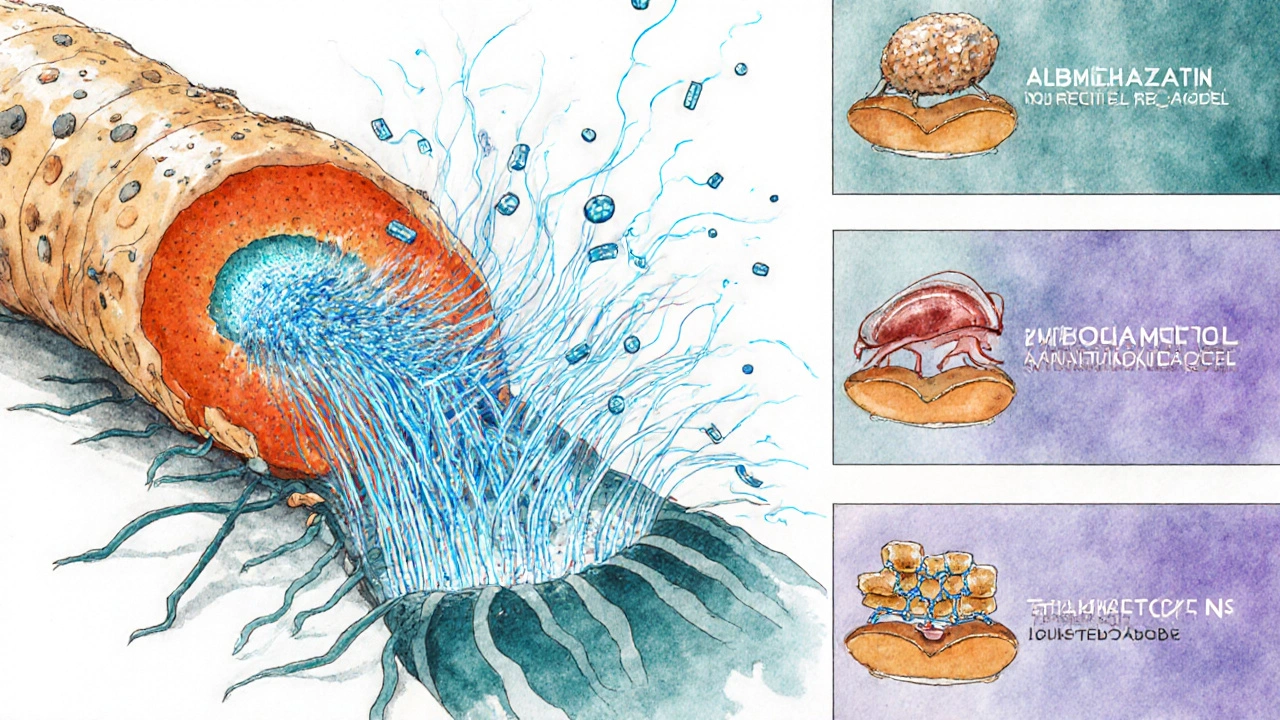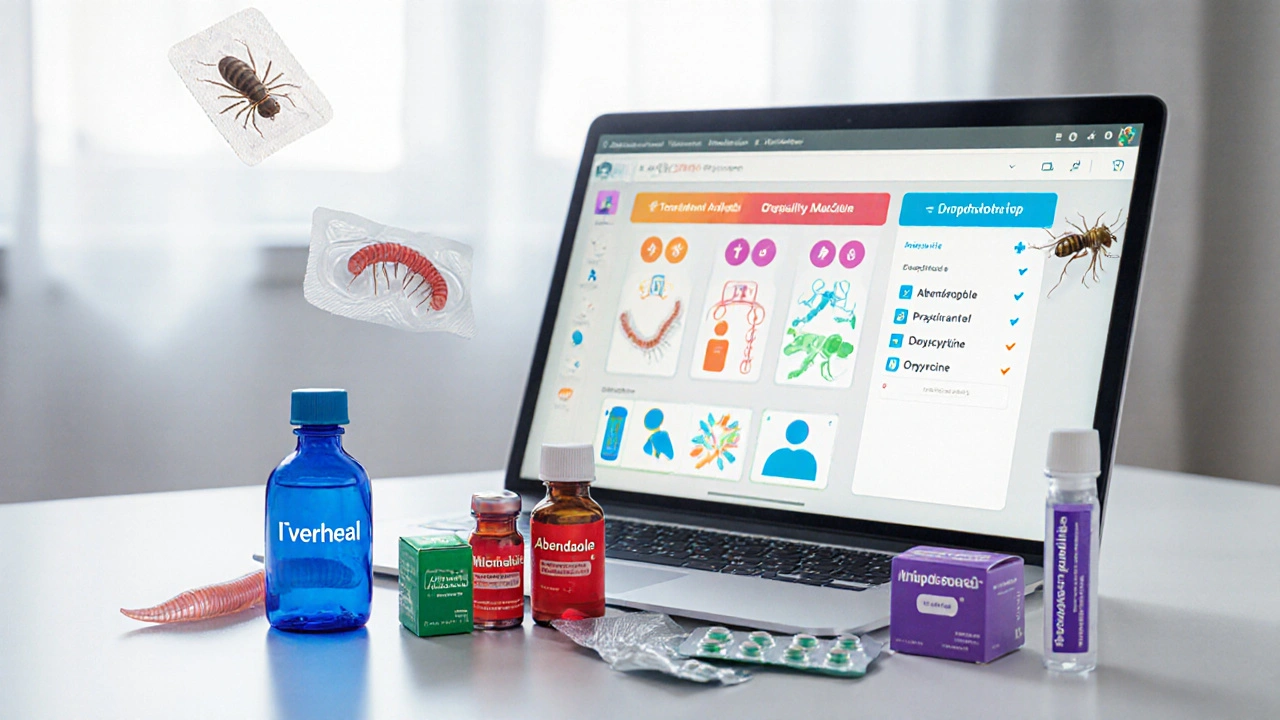Antiparasitic Treatment Selector
Select Infection Type
Patient Information
Quick Summary
- Iverheal is a brand of ivermectin used for several parasitic infections.
- It works by paralyzing parasites, but its safety profile varies with dosage.
- Alternatives like albendazole, mebendazole, praziquantel and doxycycline target different parasites or infections.
- FDA‑approved drugs such as paxlovid address viral illnesses, not parasitic ones.
- Choosing the right option depends on diagnosis, pregnancy status, cost and local guidelines.
What Is Iverheal (Ivermectin)?
When treating certain parasitic infections, Iverheal is a brand‑name formulation of ivermectin, an antiparasitic medication approved for human use in 1987. It’s widely prescribed for river blindness (onchocerciasis), strongyloidiasis, and scabies.
How Iverheal Works
Ivermectin binds to glutamate‑gated chloride channels in invertebrate nerve and muscle cells. This causes an influx of chloride ions, leading to paralysis and death of the parasite. Human cells lack these channels, which is why the drug is relatively selective.

Safety and Side‑Effect Profile
Most adults tolerate Iverheal well at approved doses (0.15-0.2 mg/kg single oral dose). Common side effects include mild itching, rash, or nausea. Rare but serious reactions-such as encephalopathy-are reported mainly in patients with high parasite loads or when doses exceed recommendations.
Pregnant women should avoid ivermectin unless the benefits clearly outweigh risks, as animal studies suggest potential fetal harm.
Common Alternatives
Below are the most frequently used drugs that serve as alternatives to Iverheal for various infections.
Albendazole is a broad‑spectrum anthelmintic effective against hookworm, roundworm, and tapeworm infections. It works by inhibiting microtubule formation in parasites.
Mebendazole targets intestinal nematodes such as Ascaris and Trichuris. It is often chosen for its safety in children.
Praziquantel treats trematode and cestode infections like schistosomiasis and neurocysticercosis. It increases parasite cell membrane permeability to calcium.
Doxycycline is a tetracycline antibiotic sometimes used for filarial diseases, notably to reduce Wolbachia bacteria in onchocerciasis. It’s administered over several weeks.
Paxlovid combines nirmatrelvir and ritonavir to treat COVID‑19; it is not an antiparasitic but often appears in comparative discussions because of ivermectin’s controversial use for viral infections.
Head‑to‑Head Comparison
| Parameter | Iverheal (Ivermectin) | Albendazole | Mebendazole | Praziquantel | Doxycycline | Paxlovid |
|---|---|---|---|---|---|---|
| Primary Indications | Onchocerciasis, strongyloidiasis, scabies | Hookworm, roundworm, tapeworm | Intestinal nematodes (Ascaris, Trichuris) | Schistosomiasis, neurocysticercosis | Filarial infections (as adjunct) | COVID‑19 (high‑risk adults) |
| Mechanism | Glutamate‑gated chloride channel agonist | Microtubule synthesis inhibition | Microtubule synthesis inhibition | Calcium influx increase | Protein synthesis inhibition (bacterial) | Protease inhibition (viral replication) |
| Typical Dose | 0.15-0.2mg/kg single oral dose | 400mg single dose (or 400mg daily ×3days) | 100mg twice daily for 3days | 40mg/kg single dose (split) | 100mg twice daily for 4-6weeks | 300mg/150mg twice daily for 5days |
| FDA Approval Year | 1987 (human use) | 1996 (US) | 1994 (US) | 2001 (US) | 1996 (US) | 2021 (Emergency Use) |
| Common Side Effects | Itching, rash, nausea | Abdominal pain, liver enzymes ↑ | Diarrhea, abdominal cramps | Dizziness, headache | Photosensitivity, GI upset | Altered taste, diarrhea |
| Cost (US$) | ≈$10-$15 per course | ≈$8-$12 | ≈$6-$10 | ≈$30-$45 | ≈$40-$60 (4‑week supply) | ≈$500 (full pack) |
| Pregnancy Safety | Category C - avoid unless essential | Category C - generally avoided | Category C - limited data | Category B - considered safe | Category D - risk outweighs benefit | Category B - safe under guidance |
Choosing the Right Option for You
Start with a confirmed diagnosis. If a doctor identifies a nematode infection like strongyloidiasis, Iverheal is often first‑line because of its high efficacy and short dosing schedule. For intestinal roundworms, albendazole or mebendazole may be cheaper and equally effective.
Consider pregnancy status: praziquantel is the safest choice for schistosomiasis in pregnant women, while ivermectin and doxycycline carry higher risk.
Cost matters in low‑resource settings. Iverheal’s generic versions can be sourced for under $10, making it a pragmatic option when the parasite is susceptible.
Finally, follow local health authority guidance. The World Health Organization issues treatment guidelines that prioritize ivermectin for onchocerciasis and strongyloidiasis in endemic regions. The U.S. Food and Drug Administration has approved ivermectin for specific parasitic diseases, not for viral infections.

Frequently Asked Questions
Can I use Iverheal to treat COVID‑19?
No. Major health agencies, including the FDA and WHO, state that ivermectin has not been proven effective for COVID‑19. Approved antivirals like Paxlovid should be used instead.
Is a single dose of Iverheal enough?
For most approved indications, a single oral dose of 0.15-0.2mg/kg is sufficient. Some infections, such as strongyloidiasis in immunocompromised patients, may require a repeat dose after two weeks.
What are the main side effects I should watch for?
Mild itching, rash, nausea, and dizziness are common. Severe reactions-like seizures or altered mental status-are rare but require immediate medical attention.
How does albendazole differ from ivermectin?
Albendazole targets a broader range of helminths by interfering with microtubule formation, whereas ivermectin acts on chloride channels specific to certain nematodes and arthropods. Dosing schedules also differ; albendazole often requires multiple days.
Is ivermectin safe for children?
Yes, when dosed correctly (0.2mg/kg). Pediatric formulations are available, and safety data show low incidence of adverse events in children older than 5years.






Adam Shooter
September 30, 2025 AT 22:00The comparative matrix you posted is a textbook case of superficial stratification; it juxtaposes pharmacodynamics without reconciling pharmacokinetic variability across demographic cohorts.
Moreover, the reliance on FDA approval dates as a proxy for clinical efficacy betrays a myopic bias toward regulatory milestones rather than real-world outcome data.
When you cite \"Category C\" for ivermectin, you neglect the nuanced teratogenic risk assessments that differentiate rodent models from primate physiology.
Overall, the table feels more like a marketing flyer than a rigorous evidence-based review.
Shanmughasundhar Sengeni
October 9, 2025 AT 00:26Honestly, the whole thing reads like someone tried to sound scholarly while actually just re‑hashing Wikipedia entries.
The pretentious headings and buzzwords mask the fact that you’ve omitted crucial contraindications, especially for pregnant patients.
We need depth, not just a pretty spreadsheet of costs and side‑effects.
ankush kumar
October 17, 2025 AT 02:53I appreciate the effort you put into assembling such a massive amount of data, and I want to make sure everyone feels welcome to dive into it without fear of judgment.
First off, the inclusion of both generic and brand‑name formulations helps readers from different healthcare systems find something they can actually access.
Second, the way you highlighted pregnancy categories across the board is a solid reminder that we can't treat all patients the same way.
Third, the cost comparison, while a bit rough, gives a useful baseline for low‑resource settings where price tags can determine health outcomes.
However, there are a few areas where additional context would make the guide even more inclusive.
For example, the table lists albendazole as $8‑$12, but in many parts of South Asia the generic version is virtually free through public health programs.
Similarly, ivermectin's price can fluctuate dramatically depending on bulk purchasing agreements, which is something community health workers should be aware of.
Another point is the mention of \"Category C\" for ivermectin in pregnancy – while technically correct, the data actually show that the risk is minimal when used at the recommended single dose, as long as the mother isn’t heavily infected with Loa loa.
I would also suggest adding a brief note about the need for repeat dosing in strongyloidiasis for immunocompromised hosts, because a single dose may not be sufficient to clear the infection.
The section on doxycycline could benefit from an explanation of why a multi‑week regimen is required to target Wolbachia, which some readers might find surprising given the drug’s usual short‑term use for bacterial infections.
On the flip side, the brief warning about paxlovid being unrelated to parasites is spot on, especially given the recent surge of misinformation linking it to antiparasitic effects.
From a practical standpoint, it could be handy to include a quick reference chart for pediatric dosing, since the current table only mentions adults and “children (5+ years)” without actual milligram specifications.
Also, a note on potential drug‑drug interactions, like ivermectin with certain anti‑seizure medications, would round out the safety profile nicely.
I understand that space is limited, but a small footnote about the importance of confirming diagnosis with stool microscopy or serology could prevent misuse of these drugs.
Overall, the guide is a commendable starting point, and with a few tweaks it could become the go‑to reference for clinicians worldwide.
Feel free to reach out if you’d like me to help flesh out any of these suggestions; collaboration makes these resources stronger for everyone.
Cameron White
October 25, 2025 AT 05:20Sounds like another pharma‑push disguised as science.
Amélie Robillard
November 2, 2025 AT 06:46Wow, a table that’s as colorful as a toddler’s crayon drawing-so helpful! 🎨
At least the emojis in the cost column make the financial despair a little more entertaining. 🙃
But seriously, kudos for trying to make it “user‑friendly.” 😏
Fae Wings
November 10, 2025 AT 09:13Haha, I get the vibe-sometimes the data feels more like a meme than medicine.
Still, those side‑effect notes actually saved me from a rash last month. 😅
Anupama Pasricha
November 18, 2025 AT 11:40Great job laying out the pharmacologic spectrum; the differentiation between microtubule synthesis inhibitors and chloride channel agonists really clarifies therapeutic pathways.
For clinicians navigating mixed infections, the combination regimen suggestions are especially valuable.
Keep emphasizing evidence‑based dosing, and consider adding a brief algorithm for co‑administration safety.
April Yslava
November 26, 2025 AT 14:06All this “evidence‑based” talk ignores the fact that big pharma silences cheaper alternatives to keep control.
Daryl Foran
December 4, 2025 AT 16:33The so‑called “quick summary” reads like a checklist for a sales rep rather than an objective analysis.
You’ve left out the meta‑analysis data that actually questions ivermectin’s superiority in onchocerciasis over albendazole in certain endemic zones.
Also, the cost column is outdated; generic ivermectin now undercuts many of the “standard” options you listed.
Dervla Rooney
December 12, 2025 AT 19:00I see your point about the cost updates; the latest WHO procurement list does show a lower price for ivermectin.
Additionally, recent trials have indeed highlighted comparable efficacy with albendazole for specific nematodes, which could be mentioned for balance.
Johnny Ha
December 20, 2025 AT 21:26Look, the global health agencies are just pushing these “approved” drugs to keep us dependent on their supply chains.
If we invested in local production of ivermectin, we’d cut out the middlemen and keep our own communities safe.